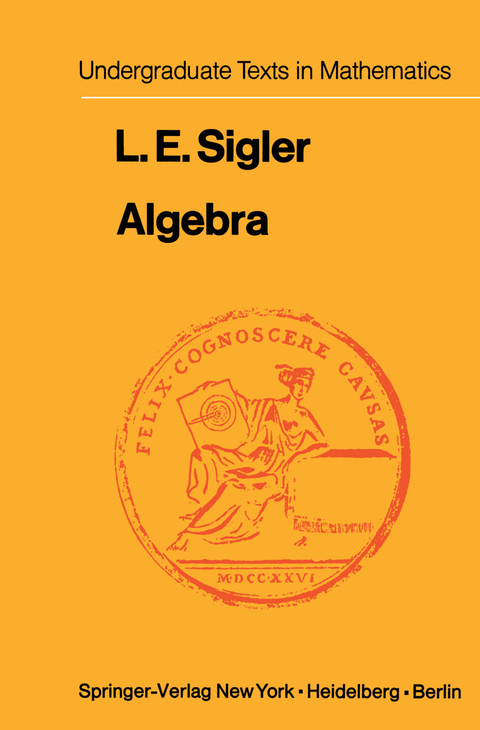
Algebra
Springer-Verlag New York Inc.
978-1-4613-9412-9 (ISBN)
There is no one best way for an undergraduate student to learn elementary algebra. Some kinds of presentations will please some learners and will disenchant others. This text presents elementary algebra organized accord ing to some principles of universal algebra. Many students find such a presentation of algebra appealing and easier to comprehend. The approach emphasizes the similarities and common concepts of the many algebraic structures. Such an approach to learning algebra must necessarily have its formal aspects, but we have tried in this presentation not to make abstraction a goal in itself. We have made great efforts to render the algebraic concepts intuitive and understandable. We have not hesitated to deviate from the form of the text when we feel it advisable for the learner. Often the presenta tions are concrete and may be regarded by some as out of fashion. How to present a particular topic is a subjective one dictated by the author's estima tion of what the student can best handle at this level. We do strive for consistent unifying terminology and notation. This means abandoning terms peculiar to one branch of algebra when there is available a more general term applicable to all of algebra. We hope that this text is readable by the student as well as the instructor. It is a goal of ours to free the instructor for more creative endeavors than reading the text to the students.
1 Set theory.- 1.1 Sets.- 1.2 Operations on sets.- 1.3 Relations.- 1.4 Quotient sets.- 1.5 Functions.- 1.6 Composition of functions.- 1.7 A factorization of a function.- 1.8 The symmetric group.- 2 Rings: Basic theory.- 2.1 Binary operations.- 2.2 The ring.- 2.3 Special rings.- 2.4 Subrings.- 2.5 Morphisms.- 2.6 Quotient rings.- 2.7 Morphisms and quotient rings.- 2.8 Ideals.- 3 Rings: Natural numbers and integers.- 3.1 The Peano axioms.- 3.2 Addition of natural numbers.- 3.3 Multiplication of natural numbers.- 3.4 Further properties of.- 3.5 Construction of the integers.- 3.6 Embedding ? in the integers.- 3.7 Ordered integral domains.- 3.8 A characterization of the integers.- 4 Rings: Applications of the integers.- 4.1 Finite sets.- 4.2 Generalized associative, commutative, and distributive theorems.- 4.3 The division algorithm for the integers.- 4.4 Multiples and exponents in a ring.- 4.5 The field of fractions.- 4.6 Characteristic of a ring.- 5 Rings: Polynomials and factorization.- 5.1 The ring of polynomials.- 5.2 A formal definition of a polynomial ring.- 5.3 Polynomial functions.- 5.4 Euclidean and principal ideal domains.- 5.5 Factorization in principal ideal domains.- 5.6 Greatest common divisor.- 5.7 Unique factorization domains.- 5.8 Field extensions and complex numbers.- 6 Linear algebra: Modules.- 6.1 Function spaces, modules, and vector spaces.- 6.2 Submodules.- Appendix 6A A method for solution of linear equations.- 6.3 Quotient modules.- 6.4 Morphisms.- 6.5 Products and direct sums.- 6.6 Families and matrices.- 6.7 Bases.- 6.8 The coordinate morphism.- 6.9 Morphisms and bases, kernel, and range.- 6.10 Vector spaces.- Appendix 6B The existence of a basis for a vector space.- Appendix 6C Equicardinality of infinite bases of a vector space.- Appendix 6DDimension of a module over a commutative unitary ring.- 7 Linear algebra: The module of morphisms.- 7.1 ?(M, M?), the module of morphisms.- 7.2 Composition of morphisms, the endomorphism algebra ?(M).- 7.3 Matrix calculation of morphisms.- 7.4 Change of basis.- 7.5 The dual space.- 7.6 Linear equations.- 7.7 Determinants.- 8 Abstract systems.- 8.1 Algebraic systems.- 8.2 Algebraic subsystems.- 8.3 Morphisms.- 8.4 Congruences and quotient systems.- 8.5 Products and sums.- 9 Monoids and groups.- 9.1 Monoids, unitary monoids, cancellative monoids, and groups.- 9.2 Congruences and quotient systems.- 9.3 Morphisms.- 9.4 Cyclic groups and order.- 9.5 Products.- 10 Linear algebra: Modules over principal domains and similarity.- 10.1 Cyclic modules.- 10.2 Invariant factors.- 10.3 Linear equations in a principal domain.- 10.4 A direct sum resolution of a finitely generated module.- 10.5 Similarity and canonical forms.- 10.6 The characteristic polynomial and characteristic values.- Selected references.- Answers to questions.- Index of symbols.
| Reihe/Serie | Undergraduate Texts in Mathematics |
|---|---|
| Zusatzinfo | 419 p. |
| Verlagsort | New York, NY |
| Sprache | englisch |
| Maße | 155 x 235 mm |
| Themenwelt | Sachbuch/Ratgeber ► Natur / Technik ► Garten |
| Mathematik / Informatik ► Mathematik ► Algebra | |
| Schlagworte | Algebra |
| ISBN-10 | 1-4613-9412-0 / 1461394120 |
| ISBN-13 | 978-1-4613-9412-9 / 9781461394129 |
| Zustand | Neuware |
| Informationen gemäß Produktsicherheitsverordnung (GPSR) | |
| Haben Sie eine Frage zum Produkt? |
aus dem Bereich


